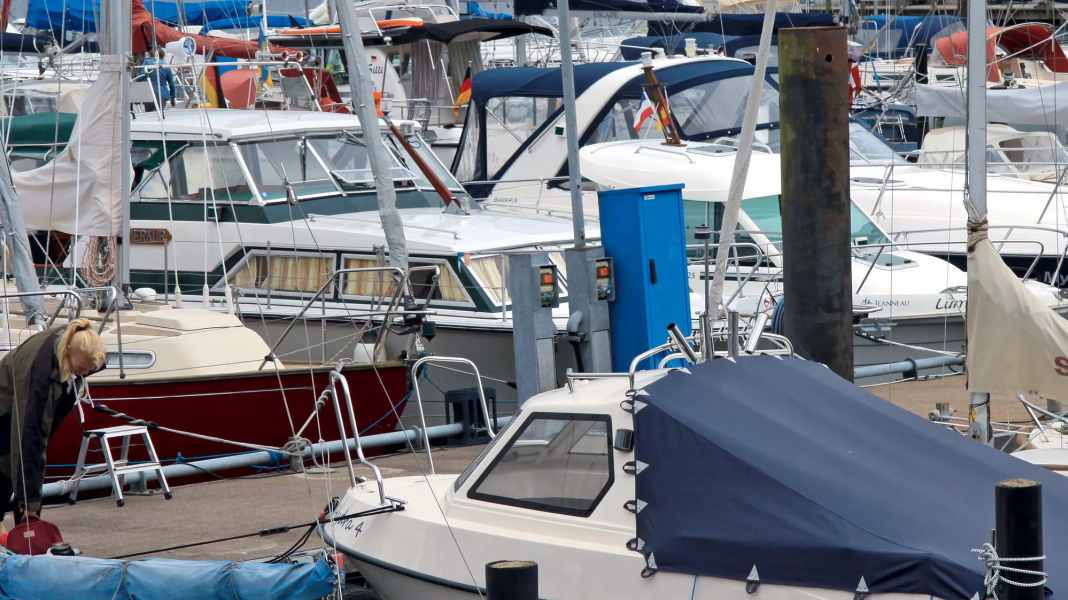
This article is part of a charter special. The contents:
- How to enjoy a relaxed charter holiday on a boat
- You can save money with these twelve tips
- The most important tips about the boat and the area
- Crew contract: Legal security when chartering
- What you need to know about the charter licence
- The right insurance for your boating holiday
- Charter checklist - Everything you need to consider
- Provisions plan and stowage tips for your holiday cruise
- Tricks for the berth - relaxed mooring
- Instruction on the catamaran - know what is where
There are lots of little tips and tricks if you want to optimally protect your boat at home or at your mooring and make mooring and unmooring easy. You often see these from neighbours on the jetty or on an evening stroll in harbours and marinas. Who has which fenders, who has thought up and built what. In the following text we present some of these solutions. What should I consider in any case? And what is a horizontal bar?
Fender
![1] Long fender 2] Simple fender mat 3] Anchor fender 4] Bow fender for round bow 5] Ball fender 6] Bow fender for pointed bow 7] Fender cushion 8] Stair fender | Drawing: M. A. Bergmann 1] Long fender 2] Simple fender mat 3] Anchor fender 4] Bow fender for round bow 5] Ball fender 6] Bow fender for pointed bow 7] Fender cushion 8] Stair fender | Drawing: M. A. Bergmann](https://media.delius-klasing.de/dk-wassersport/images/dpr_auto,fl_progressive,f_auto,c_fill,h_534,w_712/q_auto:eco/boot/boote_20221019_202211_new-img_62_15_img_8dd9baf1d4a9c2e4bd6d1d51bda13404/1-long-fender-2-simple-fender-mat-3-anchor-fender-4-bow-fender-for-round-bow-5-ball-fender-6-bow-fender-for-pointed-bow-7-fender-cushion-8-stair-fender-drawing-m-a-bergmann)
Fenders come in all kinds of shapes, colours and sizes. Which one you choose is often a matter of taste. But the most common ones, such as long fenders or ball fenders, can usually be found on every boat. Long fenders are almost always present and characterise the typical image of a boat moored in a harbour. Available in different sizes, they can be used individually for each boat. Small boats with little freeboard, i.e. a smaller distance between the water surface and the edge of the deck, use a smaller fender than a 60-foot motor yacht with a large freeboard. Long fenders are easy to handle. They are attached to a cleat or the railing with the so-called rope and hung overboard. This allows them to roll off the side of the boat. It is essential to clean fenders regularly with clear water to remove salt residue and dirt, otherwise they may rub against the hull surface and cause scratches.
If a second rope is attached, it is also possible to use the long fender as a transverse fender. In this case, however, the boat cannot "roll" on the fender, which often leads to scratches. If you want to extend the durability of fenders, there are so-called fender covers. These protect against coarse dirt and the harmful UV rays of the sun, which cause the fender material, usually PVC, to become brittle.
Other forms:
Additional protection is provided by stair, cushion, bow, stern, ring and anchor fenders
In addition to the long fender, the ball fender is one of the two best-known types. Due to its shape, it can roll better along the side of the boat and is therefore often used when mooring. The ball fender is very easy to use and has a significantly higher damping effect, as it has more volume than a long fender. Ball fenders are particularly popular on larger motorboats with a concave bow and on larger commercial vessels such as fishing boats. Ball fenders also make good buoys. They are usually bright orange in colour to ensure good visibility in the water and in cloudy weather.
Flat fenders or so-called fender cushions are another option. These are easy to stow away, which is particularly practical for smaller boats. They also don't slip much and their shape offers protection over a large area. They are ideal when locking and slipping the boat, as they do not slip and cover more area than a normal fender. However, they cannot unroll due to their design. But how many fenders should I have on board? Two to three fenders per side are ideal for boats up to around ten metres in length, as space is often limited on smaller boats and nobody wants to leave the fenders hanging on the hull all the time. On boats over ten metres in length, three to four fenders per side are used.
![1] Long fender on a ship's side 1] Long fender on a ship's side](https://media.delius-klasing.de/dk-wassersport/images/dpr_auto,fl_progressive,f_auto,c_fill,h_712,w_1068/q_auto:eco/boot/boote_20221019_202211_new-img_a765618e8f2e7746fbf005db351c0ca1/1-long-fender-on-a-ship-s-side)
![1] Long fender on a ship's side 1] Long fender on a ship's side](https://media.delius-klasing.de/dk-wassersport/images/dpr_auto,fl_progressive,f_auto,c_fill,h_93,w_120/q_auto:eco/boot/boote_20221019_202211_new-img_a765618e8f2e7746fbf005db351c0ca1/1-long-fender-on-a-ship-s-side)
![2] Bow cushion from SeaEQ protects the bow from contact with the jetty 2] Bow cushion from SeaEQ protects the bow from contact with the jetty](https://media.delius-klasing.de/dk-wassersport/images/dpr_auto,fl_progressive,f_auto,c_fill,h_93,w_120/q_auto:eco/boot/boote_20221019_202211_new-img_1dfef105c6332bcd8858efc6b1ef2112/2-bow-cushion-from-seaeq-protects-the-bow-from-contact-with-the-jetty)
![3] Ball fender at the stern 3] Ball fender at the stern](https://media.delius-klasing.de/dk-wassersport/images/dpr_auto,fl_progressive,f_auto,c_fill,h_93,w_120/q_auto:eco/boot/boote_20221019_202211_new-img_ac0a9af2b32ee5833d76965c5a2fb435/3-ball-fender-at-the-stern)
![4] Long fender with fender cover 4] Long fender with fender cover](https://media.delius-klasing.de/dk-wassersport/images/dpr_auto,fl_progressive,f_auto,c_fill,h_93,w_120/q_auto:eco/boot/boote_20221019_202211_new-img_c678a1e763dd03eda352b74a4624128a/4-long-fender-with-fender-cover)
![5] Fender cushion, particularly easy to stow away and useful for lock manoeuvres 5] Fender cushion, particularly easy to stow away and useful for lock manoeuvres](https://media.delius-klasing.de/dk-wassersport/images/dpr_auto,fl_progressive,f_auto,c_fill,h_93,w_120/q_auto:eco/boot/boote_20221019_202211_new-img_b0790315dc1cd888c043d5f1c82e9493/5-fender-cushion-particularly-easy-to-stow-away-and-useful-for-lock-manoeuvres)
In addition to the larger area that needs to be covered, the storage space situation is often less problematic and there is enough room for several fenders. However, it can generally be said that one or two more fenders on board can't do any harm anyway and are worth their weight in gold in case of doubt. You should know the total weight and windage of the boat when buying the fender. Heavy and large boats usually have a larger area exposed to the wind, which causes the boat to press more strongly into the fenders. To prevent them from bursting, they must be designed for the size of the boat.
When buying, you should also make sure that you always buy fenders of the same size. Fenders of different thicknesses and lengths are only able to protect the boat evenly to a limited extent. This is because the forces that the boat develops are then not distributed over several fenders and evenly absorbed by the hull, which increases the pressure on the individual fenders and therefore the risk of bursting.
Mooring lines
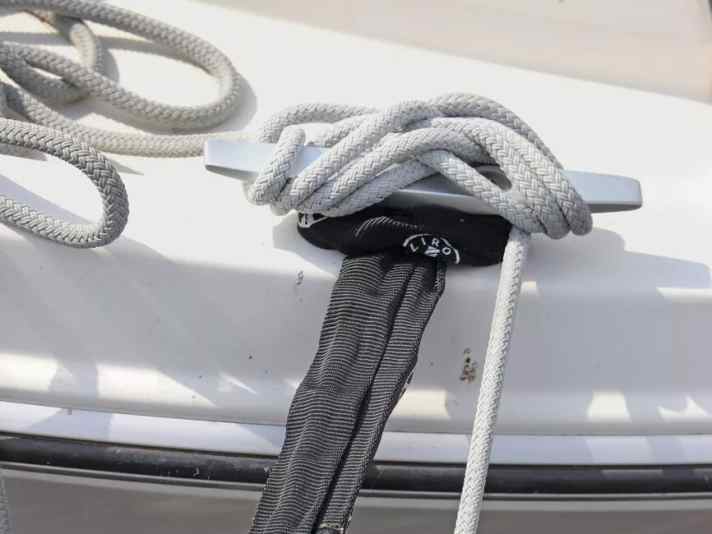
The forces acting on the boat in wind and waves are enormous. To avoid feeling every single jolt in the boat, it is important that the mooring line has "stretch". Stretch refers to the elasticity of a rope. This makes staying on board much more pleasant and protects the cleats, especially in bad weather.
The breaking load of the rope is very important and depends on the size and weight of the boat. When selecting mooring lines, it is better to play it safe and choose a higher breaking load than is actually necessary. Small chafe marks caused by rusty eyelets or cleats, which are often made of cast iron and still have a seam from the mould, can quickly weaken the cordage. If you choose a version that is too weak, the line is at risk of breaking.
It is also important to use elastic mooring lines. These are easier to splice or cover. If you have the option of having an eye spliced in, you should do so. A knot reduces the breaking load by 30 to 50 per cent, which should also be taken into account. When choosing a line, it makes sense to have an eye spliced in from the outset. The last point to mention is UV resistance. If you don't pay attention to this when buying, you often have to buy new mooring lines as the old ones become porous or brittle.
Tip:
A higher breaking load of the line never hurts.
Bar fender
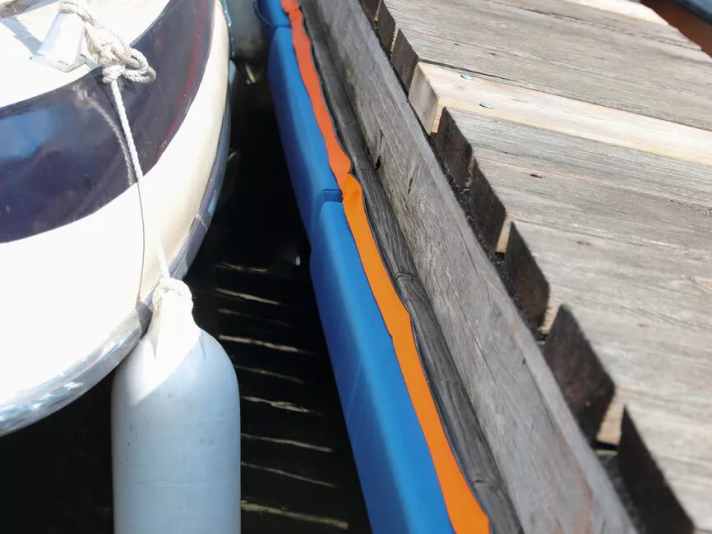
Jetty fenders are firmly attached to the berth and are bolted to the jetty. They are often attached to the head end or, in the case of floating pontoons, also to the long side. To prevent damage to the jetty, there are so-called jetty fenders, which cushion the boat like a long or ball fender and absorb the impact. They are often available to buy for less than 60 euros. They provide good protection and offer additional safety, especially for beginners.
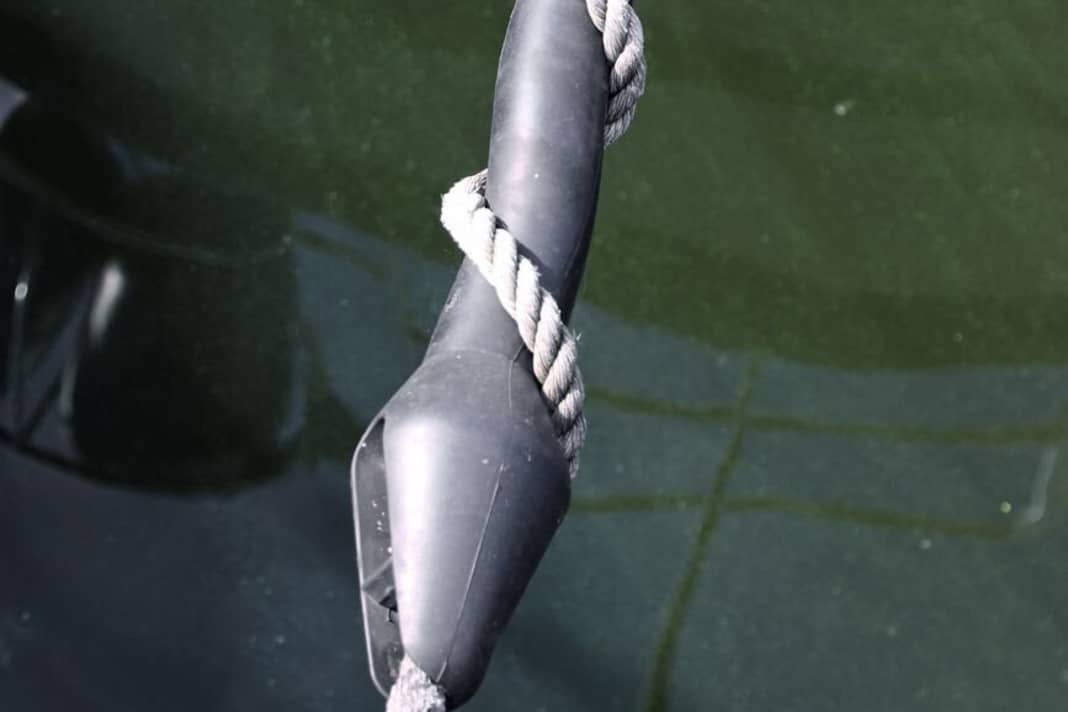


Jolt damper
In addition to the elasticity of the mooring line, shock absorbers are important to ensure that life on the boat is as pleasant as possible and that the cleats are protected from jerky loads. Jolt dampers are available in rubber or stainless steel.
Rubber shock absorbers work on the principle of wrapping one or more twists around a rubber cord. They are then attached to nylon clips at the ends. This ensures that the shock absorber is firmly attached to the line and cannot slip. In principle, the more turns you wrap around a rubber shock absorber, the more damping it will provide. A rule of thumb is to sail in waters without tide, swell or waves. Low freedom of movement for the boat, low damping. Two trips in waters with a slight surge or swell and in tidal waters. Three trips in open and less sheltered waters. Lots of freedom of movement for the boat, high damping.
Two lines are tied to the metal shock absorbers. They pull apart, cushion the jolt and then pull back together again. You should look out for high-quality and rust-free versions, as otherwise they will quickly rust and cause unpleasant noises. Ideally, every mooring line should be fitted with a shock absorber. When moored to a fixed jetty, all shock absorbers work together. If the mooring is on a floating dock, a shock absorber should not be dispensed with under any circumstances. The shock absorbers compensate for the movements of the jetty better so that they do not directly exert force on the boat.
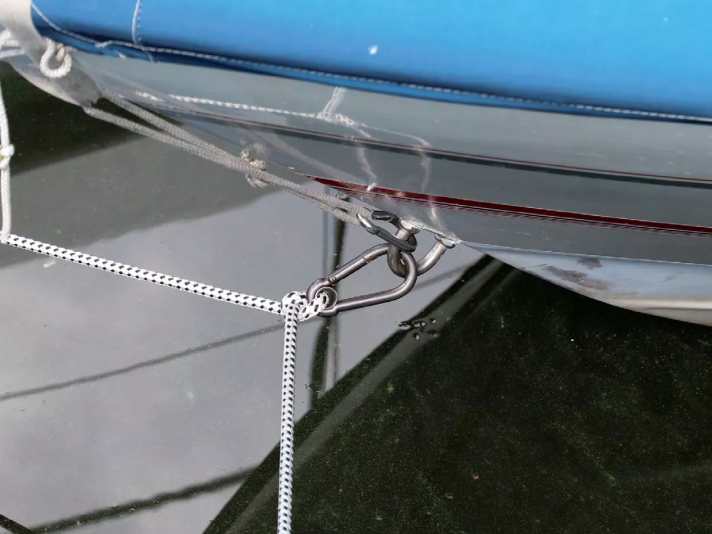
V-shaped suspension lines
The lines are attached to the cot lines and connect them. In most cases, pulleys or carabiners are attached to the lines, allowing the lines to be moved on the cot lines. A carabiner is knotted into the centre of the line. The boat is hooked into this when entering the box. This method is intended to prevent, or at least minimise, the bow from drifting in the box. If the mooring lines are well tensioned, this is a very good and popular way of optimising the berth. As the bow does not drift, mooring is much easier and the risk of drifting against another boat is minimised. In conjunction with the cut-to-length lines, mooring at the berth is child's play.
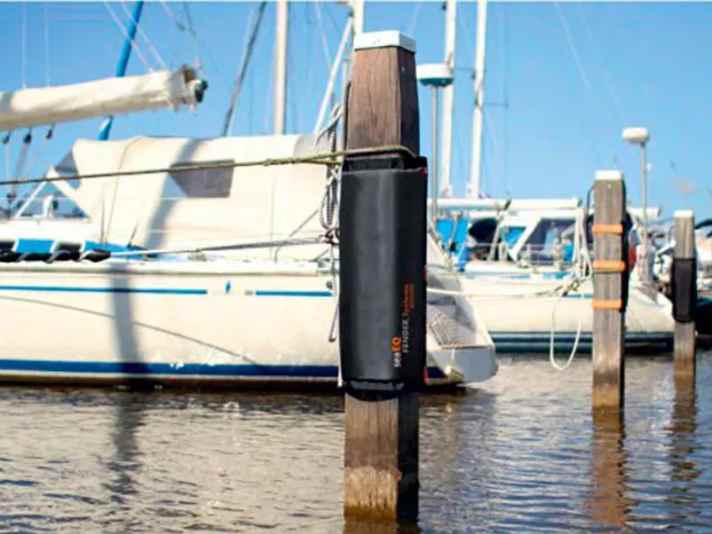
Dolphin protection
As a motorboat often has little lateral surface area, it can drift away more quickly and touch dolphins. To prevent this, dolphin cushions are available, for example from the company SeaEQ. The boat is not stopped on contact with the dolphin fender on the pile, but glides along the fender, so the boat remains manoeuvrable and does not drift in the box. If this is not the case and the poles are made of wood or even metal, scratches or dents in the outer skin are inevitable. The fenders are softly padded and are simply hung around the dolphin. They can be attached to both round and square piles. They are easy to fit using straps and can be removed without leaving any residue.
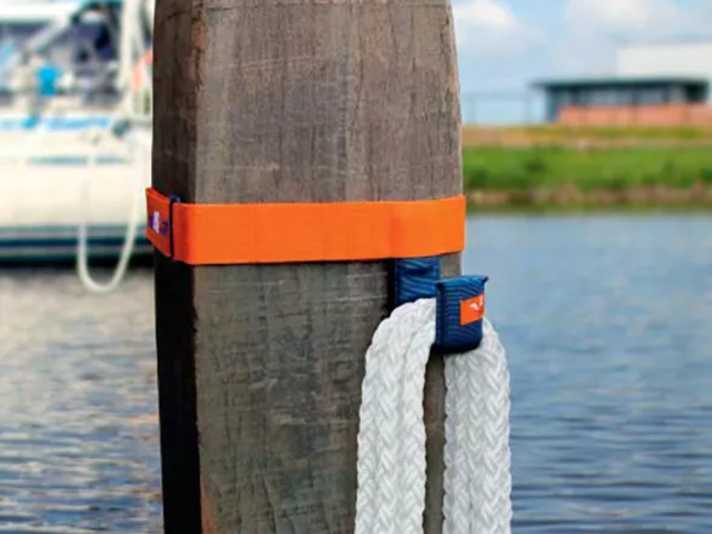
Leash holder
If you want to leave the mooring lines in the harbour, you often throw them on the jetty. But if you want the lines to stay on the stern piles, you have to come up with something. In many harbours, the piles therefore already have pre-mounted hooks, but not in every harbour. As not every harbour owner likes the idea of drilling into the dolphins, a simple, drill-free solution is often sought. One such option is the hook from SeaEQ. It is made of aluminium and covered with padded fabric and can be attached without drilling. Like the dolphin cushions, it is mounted with retaining straps. The hook can be attached to round or square dolphins and is available in various designs. The mooring line can now be easily picked up again during mooring manoeuvres.

Care line
Caution lines are stretched between the jetty and the dolphins. They delimit the berth to the sides and you can hold on to them when mooring or casting off. They also prevent the boat from drifting sideways in the box. They protect other boats, as well as your own, from being touched by your neighbours.
Conclusion
There are many different types of fenders as well as tips and tricks. Everyone has to decide for themselves what is suitable for their own berth. If the berth is in a box, cutting the lines to length, the port and starboard safety lines and the bow lines are a good solution. They simplify the mooring manoeuvre and ensure that everything runs smoothly. For choppy waters, we also recommend additional shock absorbers.
For orientation:

The values are a rule of thumb as to what strength of mooring line you should have for which boat. Polyester and polyamide are the two most common types of rope. However, the manufacturer's specifications should also be taken into account when purchasing
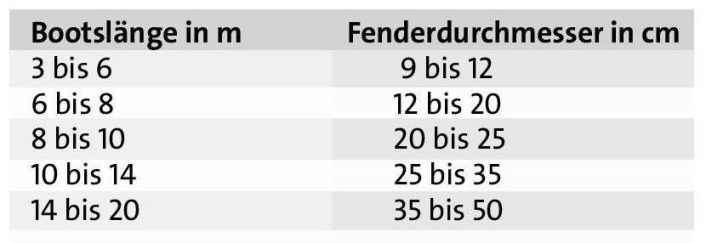
This article is part of a charter special. The contents:
- How to enjoy a relaxed charter holiday on a boat
- You can save money with these twelve tips
- The most important tips about the boat and the area
- Crew contract: Legal security when chartering
- What you need to know about the charter licence
- The right insurance for your boating holiday
- Charter checklist - Everything you need to consider
- Provisions plan and stowage tips for your holiday cruise
- Tricks for the berth - relaxed mooring
- Instruction on the catamaran - know what is where

